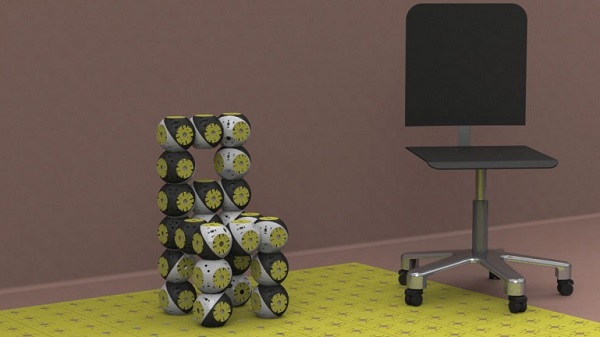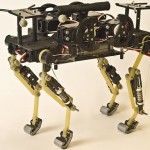
With the Roombots, the robotic modules that transform themselves into various pieces of furniture, you can no longer blame your better half or your mother-in-law for any changes in the interior design of your apartment.
A product of the Swiss researchers from the Biorobotics Laboratory (BioRob) at École polytechnique fédérale de Lausanne (EPFL), Roombots connect to one another in order to form various types of furniture, and can easily change their shape to something else when required. Do you have too many tables and not enough chairs (or the other way around)? Roombots can help you with that, as flexibility is their middle name.
Massimo Vespignani, a PhD student at BioRob, stated in an interview with GizMag that “We start from a group of Roombot modules that might be stacked together for storage. The modules detach from this pile to form structures of two or more modules. At this point they can start moving around the room in what we call off-grid locomotion. We are currently trying to control larger structures, while trying to reduce as much as possible the energy consumption and impacts with the ground.”
Vespignani also explained how these robotic pieces of furniture are supposed to work: “A single module can autonomously reach any position on a plane (this being on the floor, walls, or ceiling), and overcome a concave edge. In order to go over convex edges two modules need to collaborate.”
The shape of the modules enables people to transport them easily, as stacking them together is not difficult at all: “The advantage would be that the modules can be tightly packed together for transportation and then can reconfigure into any type of structure (for example a robotic manipulator).”
Roombots can work on their own, or they can be used to enhance existing pieces of furniture, as Vespignani explained: “We can ‘augment’ existing furniture by placing compatible connectors on it and attaching Roombots modules to allow it to move around the house.”
Are you already shouting virtually at the developers of these tiny robots to shut up and take your money? Well, don’t hold your breath, as Vespignani estimates that it will take a couple of decades until these hit the market: “Our ultimate goal is for sure to improve the quality of life. There are still a lot of research questions and technical challenges to solve. I would say they could be in the market in 20 years.”
Be social! Follow Walyou on Facebook and Twitter, and read more related stories about the telescopic contact lens that lets wearers zoom in/out at will and the Swiss robot cheetah cub.
 Contact lenses have always been a convenient and fashionable way of aiding vision, but the ability to zoom in and …
Contact lenses have always been a convenient and fashionable way of aiding vision, but the ability to zoom in and … Researchers from École Polytechnique Fédérale de Lausanne (EPFL) developed a cheetah-shaped robot that brings to mind DARPA’s creations instantly, despite …
Researchers from École Polytechnique Fédérale de Lausanne (EPFL) developed a cheetah-shaped robot that brings to mind DARPA’s creations instantly, despite …

